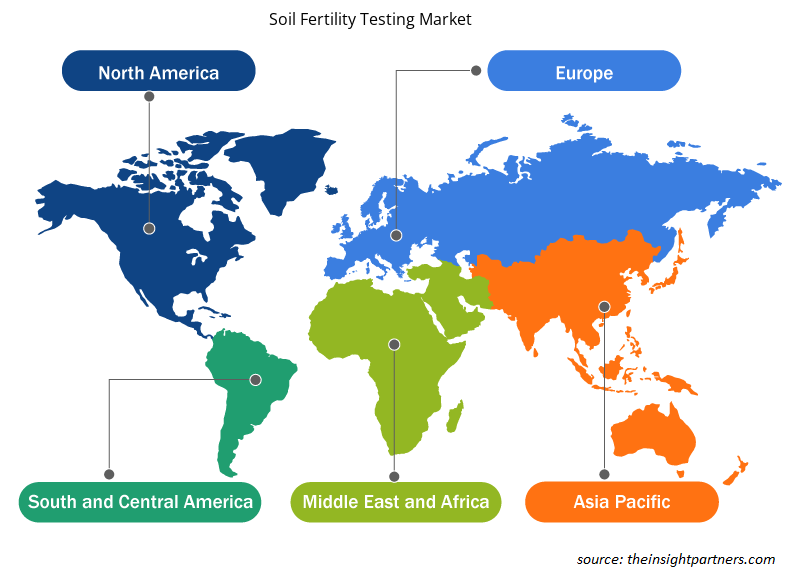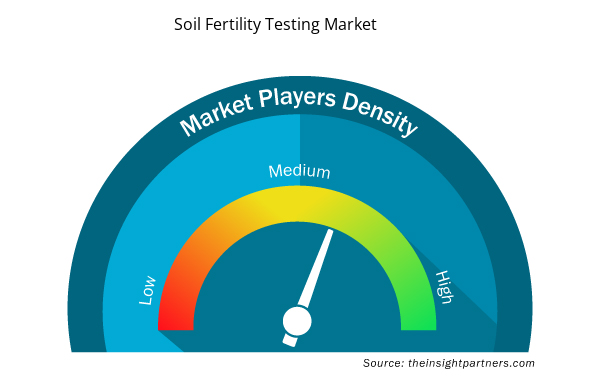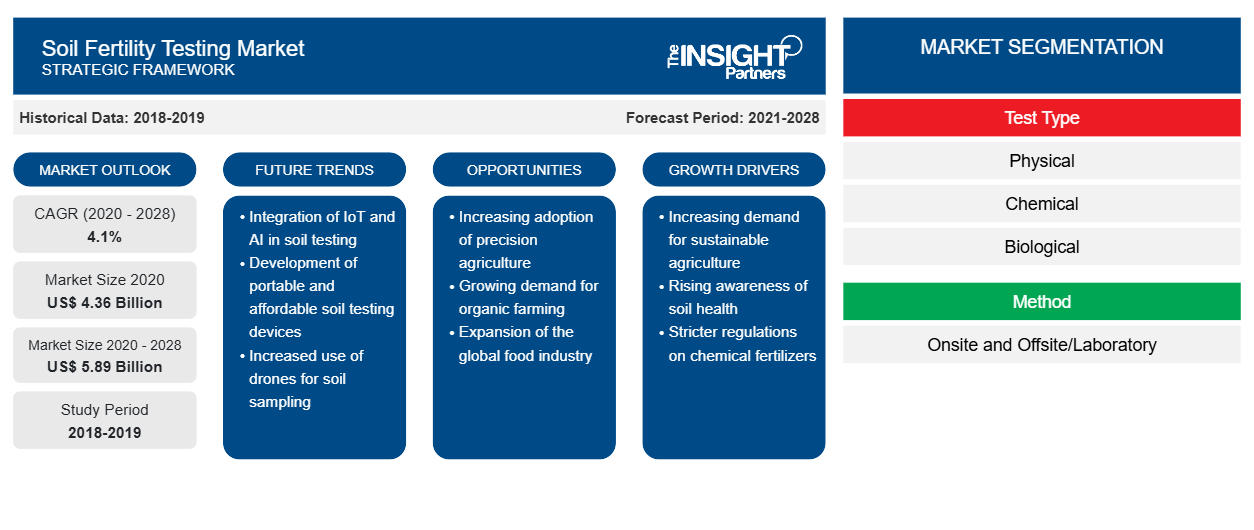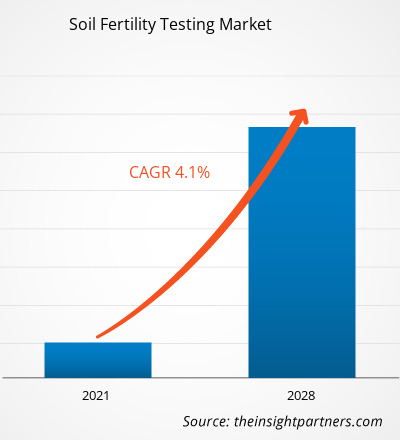土壤肥力测试市场价值为2020 年为 43.5551 亿美元,预计到 2028 年将达到 58.9106 亿美元;预计 2021 年至 2028 年的复合年增长率为 4.1%。
土壤肥力测试有助于确定土壤的生长潜力,表明养分不足、肥力过高导致的潜在毒性以及非必需微量矿物质造成的抑制。测试结果还可用于确定是否需要模拟根系吸收矿物质的能力。
预计亚太地区土壤肥力测试市场在预测期内将以最高复合年增长率增长。该地区市场的增长主要归因于对优质农产品和原料的需求增加,以及中国和印度农业实践的快速进步。日本是该地区土壤肥力测试市场增长的另一个重要贡献者。
定制此报告以满足您的需求
您可以免费定制任何报告,包括本报告的部分内容、国家级分析、Excel 数据包,以及为初创企业和大学提供优惠和折扣
- 获取此报告的关键市场趋势。这个免费样品将包括数据分析,从市场趋势到估计和预测。
COVID-19 疫情对土壤肥力测试市场的影响
由于农业活动放缓、供应链不稳定、贸易流动受限以及劳动力供应减少等原因,COVID-19 疫情扰乱了土壤肥力检测市场。由于国家和国际边界突然关闭,疫情扭曲了运营效率并扰乱了价值链。然而,随着各经济体计划恢复运营,预计未来几个月全球对土壤肥力检测的需求将上升。此外,由于 COVID-19 病例数量的增加,对健康粮食作物、水果和蔬菜的需求以及对营养丰富和增强免疫力的食品的需求有所增加,这将支持土壤肥力检测市场的增长。此外,在疫情期间,农业占 GDP 12-16% 的印度、孟加拉国和越南等农业国家受到的打击最严重。尽管各国政府宣布了针对小农户的救济计划和一揽子计划,但农业部门的表现一直在下降。加州供应了美国近三分之一的水果和蔬菜,但2020年疫情激增导致加州农产品供应受限,进而阻碍了该国土壤肥力检测市场的增长。
市场洞察
政府对农作物营养成分的严格监管促进了燃料土壤肥力测试市场的增长
施用肥料,尤其是合成肥料,会导致有害气体释放到大气中,从而危害环境。因此,各国制定了多项规则,禁止向大气排放此类有害气体。例如,食品和药物管理局 (FDA) 负责监管在州际贸易中销售的国内和进口食品;确保食品的安全、卫生、营养成分、健康以及产品标签的适当性。此外,《农业经营条例》(2002 年)旨在通过确保土壤中磷的有效平衡来保持土壤肥力并减少过量施肥造成的损失,从而解决农业活动造成的弥散污染问题。该条例还包括牲畜结构和粪便管理标准以及限制水污染的土地使用条例。此外,在美国、加拿大、澳大利亚和欧盟等国家,人们非常重视监测政策框架及其严格执行,以实现更大的供应链透明度并确保可追溯性。此类行动确保受感染的食品、饲料和农产品在边境被拒收,并经过适当处理后才能通过边境进一步在国内销售。违反者将被处以高额罚款或吊销执照。因此,为了满足各监管机构制定的安全和质量要求,农业产量测试越来越多地被用作预防措施。
土壤肥力测试提供有关土壤健康和作物所需适当营养的信息,以及有关施用于土壤的化学品及其对土壤的影响的信息。土壤污染预计将对当地生态产生不利影响,包括植物和人类。土壤中的有毒物质会降低土壤肥力并降低土壤产量。如果利用这种土壤种植水果和蔬菜,产量将缺乏关键营养,并可能含有可能导致严重健康问题的危险化合物。此外,在出口时,必须检查作物的营养价值,因为它们应该符合各国政府规定的要求。进行土壤肥力测试是为了避免此类后果。因此,政府对食品营养成分的严格规定刺激了土壤肥力测试市场的增长。
测试类型洞察
根据测试类型,土壤肥力测试市场分为物理、化学和生物。化学品行业在 2020 年占据了最大的市场份额,预计在预测期内将实现市场最高复合年增长率。化学土壤测试已成为避免向农场系统输入过多营养物质的监测工具。这些测试有助于确定磷、氮、钾、有效石灰、有机物、硫和微量元素等植物必需营养物质的浓度,以及其他物理特性,如容量、渗透性、密度和 pH 值。此外,土壤化学测试有助于优化作物生产、保护环境免受过量肥料径流和浸出造成的污染、诊断植物培养问题以及增强生长介质的营养平衡。
方法见解
根据方法,土壤肥力测试市场分为现场和场外/实验室。场外/实验室部分在 2020 年占据了更大的市场份额,预计在预测期内将在市场上实现更高的复合年增长率。场外土壤测试方法包括有机物水平、显微镜、生物活动、熏蒸和分子方法。在实验室中,原子吸收分光光度计、电感耦合等离子体光谱仪 (ICP)、拉查特流动注射分析仪、比色计和其他实验室设备用于检查土壤肥力。土壤肥力测试的实验室方法提供有关土壤状态和管理、土壤肥力管理、减少化肥支出的必要性以及避免过度施肥和防止土壤恶化的方法的知识。
土壤肥力测试市场中的一些主要参与者包括 SGS SA、Eurofins Scientific、ALS Limited、Agrolab GmbH、Actlabs、Agrocares、Water Agriculture Laboratories, Inc.、Polytest Laboratories、Crop Nutrition Laboratory Services Ltd. 和 A and L Great Lakes。这些主要公司实施并购和研发战略,以扩大客户群并在全球市场中获得显著份额,这也使他们能够在全球范围内保持自己的品牌名称。
土壤肥力测试市场区域洞察
Insight Partners 的分析师已详细解释了预测期内影响土壤肥力测试市场的区域趋势和因素。本节还讨论了北美、欧洲、亚太地区、中东和非洲以及南美和中美洲的土壤肥力测试市场细分和地理位置。

- 获取土壤肥力测试市场的区域具体数据
土壤肥力测试市场报告范围
| 报告属性 | 细节 |
|---|---|
| 2020 年市场规模 | 43.6亿美元 |
| 2028 年市场规模 | 58.9 亿美元 |
| 全球复合年增长率(2020 - 2028) | 4.1% |
| 史料 | 2018-2019 |
| 预测期 | 2021-2028 |
| 涵盖的领域 | 按测试类型
|
| 覆盖地区和国家 | 北美
|
| 市场领导者和主要公司简介 |
|
土壤肥力测试市场参与者密度:了解其对业务动态的影响
土壤肥力测试市场正在快速增长,这得益于终端用户需求的不断增长,而这些需求又源于消费者偏好的不断变化、技术进步以及对产品优势的认识不断提高等因素。随着需求的增加,企业正在扩大其产品范围,进行创新以满足消费者的需求,并利用新兴趋势,从而进一步推动市场增长。
市场参与者密度是指在特定市场或行业内运营的企业或公司的分布情况。它表明在给定市场空间中,相对于其规模或总市场价值,有多少竞争对手(市场参与者)存在。
在土壤肥力测试市场运营的主要公司有:
- 瑞士通用公证行
- 欧陆科技
- 艾力士有限公司
- 农业保健公司
- 行动实验室
免责声明:上面列出的公司没有按照任何特定顺序排列。

- 了解土壤肥力测试市场的主要参与者概况
报告亮点
- 土壤肥力测试市场的渐进式行业趋势可帮助参与者制定有效的长期战略
- 公司采用的业务增长战略来确保发达市场和发展中市场的增长
- 2019 年至 2028 年土壤肥力测试市场定量分析
- 全球土壤肥力检测需求估计
- PEST 分析可说明行业内买家和供应商的效率
- 了解竞争市场状况的最新发展
- 市场趋势和前景以及推动和抑制土壤肥力测试市场增长的因素
- 通过强调支撑商业利益的市场策略来协助决策过程,从而促进市场增长
- 各节点土壤肥力检测市场规模
- 市场的详细概述和细分,以及土壤肥力测试行业动态
- 各地区土壤肥力检测市场规模及增长潜力巨大
土壤肥力测试市场 – 按测试类型
- 身体的
- 化学
- 生物
土壤肥力测试市场 – 按方法分类
- 现场
- 场外/实验室
公司简介
- 瑞士通用公证行
- 欧陆科技
- 艾力士有限公司
- 农业实验室有限公司
- 行动实验室
- 农业保健公司
- 沃特世农业实验室有限公司
- Polytest 实验室
- 作物营养实验室服务有限公司
- A 和 L 五大湖
- 历史分析(2 年)、基准年、预测(7 年)及复合年增长率
- PEST 和 SWOT 分析
- 市场规模价值/数量 - 全球、区域、国家
- 行业和竞争格局
- Excel 数据集



Report Coverage
Revenue forecast, Company Analysis, Industry landscape, Growth factors, and Trends

Segment Covered
This text is related
to segments covered.

Regional Scope
North America, Europe, Asia Pacific, Middle East & Africa, South & Central America

Country Scope
This text is related
to country scope.
常见问题
Chemical soil tests have emerged as a monitoring tool for avoiding excessive nutrient input to the farm system. These tests help determine the concentration of essential plant nutrients such as phosphorus, nitrogen, potassium, available lime, organic matter, sulfur, and trace elements as well as other physical properties such as capacity, permeability, density, and pH. Further, the soil chemical testing assists in the optimization of crop production, protection of the environment from contamination caused by runoff and leaching of excess fertilizers, diagnosis of plant culture problems, and enhancement of nutritional balance of the growing media.
The major players operating in the global soil fertility testing market are SGS SA; Eurofins Scientific; ALS Limited; Agrolab GmbH; Actlabs; Agrocares; Water Agriculture Laboratories, Inc.; Polytest Laboratories; Crop Nutrition Laboratory Services Ltd.; and A and L Great Lakes among many others.
Soil fertility testing helps determine the growth potential of soil, indicating inadequacies of nutrients, potential toxicity caused by excessive fertility, and inhibitions due to non-essential trace minerals. Soil fertility testing has become widely accepted in the agriculture sector in the last few years for achieving higher field yields and revenues. Based, on test type, the global soil fertility testing market has been segmented into physical, chemical, and biological. Based on method, it has been segmented into onsite and offsite/laboratory.
Trends and growth analysis reports related to Consumer Goods : READ MORE..
The List of Companies - Soil Fertility Testing Market
- SGS SA
- Eurofins Scientific
- ALS Limited
- Agrocares
- Actlabs
- Agrolab GmbH
- Water Agriculture Laboratories Inc.
- Polytest Laboratories
- Crop Nutrition Laboratory Services Ltd
- A and L
- Great Lakes
The Insight Partners performs research in 4 major stages: Data Collection & Secondary Research, Primary Research, Data Analysis and Data Triangulation & Final Review.
- Data Collection and Secondary Research:
As a market research and consulting firm operating from a decade, we have published and advised several client across the globe. First step for any study will start with an assessment of currently available data and insights from existing reports. Further, historical and current market information is collected from Investor Presentations, Annual Reports, SEC Filings, etc., and other information related to company’s performance and market positioning are gathered from Paid Databases (Factiva, Hoovers, and Reuters) and various other publications available in public domain.
Several associations trade associates, technical forums, institutes, societies and organization are accessed to gain technical as well as market related insights through their publications such as research papers, blogs and press releases related to the studies are referred to get cues about the market. Further, white papers, journals, magazines, and other news articles published in last 3 years are scrutinized and analyzed to understand the current market trends.
- Primary Research:
The primarily interview analysis comprise of data obtained from industry participants interview and answers to survey questions gathered by in-house primary team.
For primary research, interviews are conducted with industry experts/CEOs/Marketing Managers/VPs/Subject Matter Experts from both demand and supply side to get a 360-degree view of the market. The primary team conducts several interviews based on the complexity of the markets to understand the various market trends and dynamics which makes research more credible and precise.
A typical research interview fulfils the following functions:
- Provides first-hand information on the market size, market trends, growth trends, competitive landscape, and outlook
- Validates and strengthens in-house secondary research findings
- Develops the analysis team’s expertise and market understanding
Primary research involves email interactions and telephone interviews for each market, category, segment, and sub-segment across geographies. The participants who typically take part in such a process include, but are not limited to:
- Industry participants: VPs, business development managers, market intelligence managers and national sales managers
- Outside experts: Valuation experts, research analysts and key opinion leaders specializing in the electronics and semiconductor industry.
Below is the breakup of our primary respondents by company, designation, and region:

Once we receive the confirmation from primary research sources or primary respondents, we finalize the base year market estimation and forecast the data as per the macroeconomic and microeconomic factors assessed during data collection.
- Data Analysis:
Once data is validated through both secondary as well as primary respondents, we finalize the market estimations by hypothesis formulation and factor analysis at regional and country level.
- Macro-Economic Factor Analysis:
We analyse macroeconomic indicators such the gross domestic product (GDP), increase in the demand for goods and services across industries, technological advancement, regional economic growth, governmental policies, the influence of COVID-19, PEST analysis, and other aspects. This analysis aids in setting benchmarks for various nations/regions and approximating market splits. Additionally, the general trend of the aforementioned components aid in determining the market's development possibilities.
- Country Level Data:
Various factors that are especially aligned to the country are taken into account to determine the market size for a certain area and country, including the presence of vendors, such as headquarters and offices, the country's GDP, demand patterns, and industry growth. To comprehend the market dynamics for the nation, a number of growth variables, inhibitors, application areas, and current market trends are researched. The aforementioned elements aid in determining the country's overall market's growth potential.
- Company Profile:
The “Table of Contents” is formulated by listing and analyzing more than 25 - 30 companies operating in the market ecosystem across geographies. However, we profile only 10 companies as a standard practice in our syndicate reports. These 10 companies comprise leading, emerging, and regional players. Nonetheless, our analysis is not restricted to the 10 listed companies, we also analyze other companies present in the market to develop a holistic view and understand the prevailing trends. The “Company Profiles” section in the report covers key facts, business description, products & services, financial information, SWOT analysis, and key developments. The financial information presented is extracted from the annual reports and official documents of the publicly listed companies. Upon collecting the information for the sections of respective companies, we verify them via various primary sources and then compile the data in respective company profiles. The company level information helps us in deriving the base number as well as in forecasting the market size.
- Developing Base Number:
Aggregation of sales statistics (2020-2022) and macro-economic factor, and other secondary and primary research insights are utilized to arrive at base number and related market shares for 2022. The data gaps are identified in this step and relevant market data is analyzed, collected from paid primary interviews or databases. On finalizing the base year market size, forecasts are developed on the basis of macro-economic, industry and market growth factors and company level analysis.
- Data Triangulation and Final Review:
The market findings and base year market size calculations are validated from supply as well as demand side. Demand side validations are based on macro-economic factor analysis and benchmarks for respective regions and countries. In case of supply side validations, revenues of major companies are estimated (in case not available) based on industry benchmark, approximate number of employees, product portfolio, and primary interviews revenues are gathered. Further revenue from target product/service segment is assessed to avoid overshooting of market statistics. In case of heavy deviations between supply and demand side values, all thes steps are repeated to achieve synchronization.
We follow an iterative model, wherein we share our research findings with Subject Matter Experts (SME’s) and Key Opinion Leaders (KOLs) until consensus view of the market is not formulated – this model negates any drastic deviation in the opinions of experts. Only validated and universally acceptable research findings are quoted in our reports.
We have important check points that we use to validate our research findings – which we call – data triangulation, where we validate the information, we generate from secondary sources with primary interviews and then we re-validate with our internal data bases and Subject matter experts. This comprehensive model enables us to deliver high quality, reliable data in shortest possible time.


 获取此报告的免费样本
获取此报告的免费样本